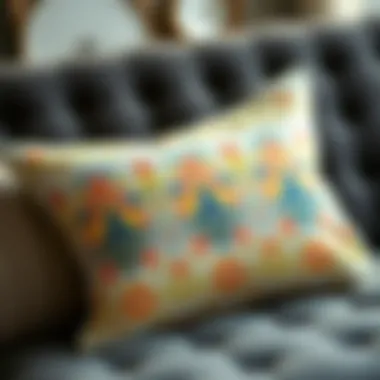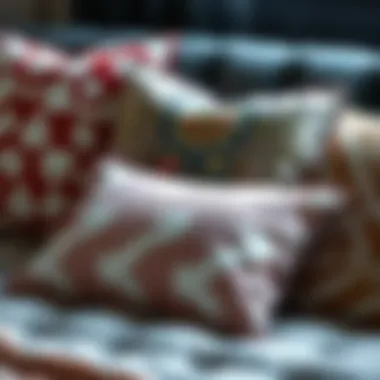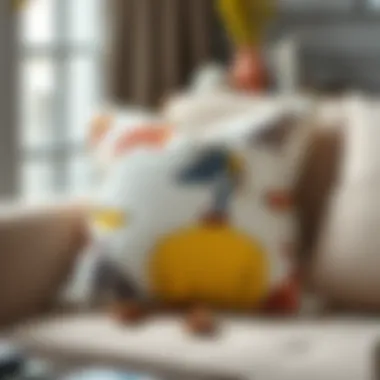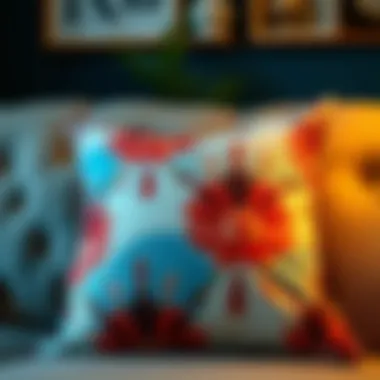The Comprehensive Guide to Customised Cushion Covers


Intro
When it comes to home decor, few items can make as significant an impact as cushion covers. These fabric adornments are not just for comfort; they carry personal stories, exhibit cultural backgrounds, and showcase a blend of the functional with the aesthetic. In this guide, we will delve into the extensive world of customised cushion covers, dissecting their role in personal expression, material choices, design intricacies, and the cultural significance they hold.
Each cushion cover is an opportunity for individual creativity, allowing one to express style preferences and aspirations. From vibrant patterns to subtle textures, these covers serve as vital components of both interior design and personal identity. More than mere accessories, customised cushion covers can transform an ordinary space into a reflection of one's personality, style, and even heritage.
Furthermore, as we navigate through the fabric types and design choices available, environmental considerations will also surface. The selection of eco-friendly materials in creating customized pieces not only reflects contemporary values but also fosters a sense of responsibility towards Mother Earth. Trendy, yet mindful, the cushion cover evolution encapsulates a growing awareness of sustainable living. Let's journey through this vibrant tapestry of design, style, and cultural resonance, where every pattern tells a story and every fabric choice makes an impact.
Foreword to Customised Cushion Covers
In the world of interior design, cushion covers play a pivotal role, often overlooked in favor of more substantial furnishings. However, they hold untapped potential, offering avenues for personal expression and aesthetic enhancement. As we delve into customised cushion covers, it’s essential to appreciate why these seemingly simple items hold significance. They don’t just serve the purpose of comfort; they can transform an area, breathing life into a dull space.
Customisation allows individuals to tailor their living environments to their personal tastes. This aspect is no longer about just choosing between floral patterns or geometric shapes. Rather, it’s about crafting a unique identity through design. Whether you opt for a bold design that makes a statement or a subtle pattern that complements the overall decor, the choice is vital. Not only does it reflect personal style, but it also promotes a feeling of belonging and comfort in one’s own space.
Understanding Customisation
When it comes to cushion covers, customisation revolves around multiple factors, including material selection, color palettes, and design patterns. It isn’t a monolithic concept but a spectrum of choices available to consumers.
For example, consider someone who loves the energetic vibes of tropical designs. They might choose bright colors, lush patterns, and even textural variations in the fabric. On the other hand, another individual may prefer a minimalist approach, choosing neutral tones and clean lines. This choice enables them to express who they are as individuals, all while crafting a comfortable environment.
One of the most exciting innovations in cushion cover customisation is the use of digital print technology. Instead of limiting oneself to pre-existing patterns, consumers can now create their own unique designs based on personal photographs or custom illustrations. This capability to design has democratized the art of interior decor, empowering individuals to take the reins and inject their personality into their surroundings.
The Role of Cushion Covers in Interior Design
Cushion covers should not be underestimated in their significant impact on interior design aesthetics. They act as the proverbial cherry on top, adding the finishing touch to living spaces. The strategic placement of cushion covers can subtly influence the overall ambiance of the room, guiding the observer's emotions.
For instance, in a rich, wooden-themed living room, vibrant cushion covers can introduce pops of color, enlivening the space. Conversely, for a modern monochrome room, textures become paramount; unique fabrics can lend depth and intrigue to a simple color palette, breaking the visual monotony. It's all about finding harmony in design.
Furthermore, cushion covers enhance the comfort factor of any seating arrangement. They not only provide support but can also be a reflection of the trends in design. With the rise of sustainable fashion, many cushion covers are tailored from eco-friendly materials, aligning aesthetics with ethical considerations.
In buyer psychology, there's a clear understanding that a well-designed cushion can elevate not just the space but also the perceived value of the overall environment. As such, designers and homeowners alike are increasingly recognizing the importance of these elements.
Internally, these choices influence the mood of a space and ultimately affect how people experience their environments. Thus, customised cushion covers become more than just decorative items; they evolve into vital components of interior design narratives. As we continue through this guide, we will explore further how materials, techniques, and current trends intertwine in the bespoke journey of cushion covers.
Historical Context
Understanding the historical context surrounding customised cushion covers is crucial for grasping their evolving role in design and personal expression. From mere functional items to significant design elements, cushion covers have traversed a fascinating journey. This journey is paved with cultural narratives and artistic intentions that speak volumes about societal values over the years.
Evolution of Cushion Covers
The evolution of cushion covers is not merely a tale of fabric and seams. Historically, these decorative items began as practical necessities to provide comfort and support. The earliest known textiles date back thousands of years to ancient civilizations such as Egypt and Mesopotamia, where simple linen or woolen fabrics were used. As time marched on, these covers transformed in both form and function.
In the Middle Ages, cushion covers became a canvas for craftsmanship. Artisans began embellishing them with intricate embroidery and vibrant patterns, reflecting the cultural wealth of the time. As the Renaissance dawned, cushion covers blossomed into statements of wealth and status. Each home decked with vibrantly colored fabrics, featuring bold designs that showcased the owners' preferences and artistic tastes.


By the 19th century, the Industrial Revolution introduced machine-made fabrics, revolutionizing the production of cushion covers. Accessibility of materials led to a surge in creativity, as people began to explore personalized designs that aligned with their unique tastes. This democratization of design meant that cushion covers were no longer exclusive to the elite; they became available to the everyday folk.
Today, the evolution continues with advances in technology. Customisation options have expanded greatly, enabling consumers to print family photos or personal messages onto cushion covers. This shift reflects a deeper desire for individuality and self-expression in living spaces. The cushion cover has become, therefore, a mirror reflecting personal identity and preferences within design aesthetics.
Cultural Significance Across Eras
Through the tapestry of history, the cultural significance of cushion covers has fluctuated and transformed. In various eras, these items have been valued not only for their aesthetic appeal but also for their symbolism in different societies.
- Ancient Civilizations: In cultures such as those of Mesopotamia, cushion-like supports were often seen accompanying important ritual rites. They held symbolic meaning tied to comfort and respect.
- Middle Ages to Renaissance: During these periods, cushion covers adorned churches and significant public places—often richly embroidered or even woven from gold threads. The designs would carry specific symbols of faith or community influence, thus anchoring them deeply in their cultural contexts.
- Modern Times: Fast forward to contemporary society where cushion covers embody more than functionality; they express beliefs, values, and societal norms. In today's world, they serve as a unique medium for personal storytelling. Through customized patterns, colors, and images, individuals convey their cultural identities and personal histories, contributing to a broader conversation about aesthetics and belonging.
"Cushion covers are not just about decoration; they are a means of storytelling within our living spaces, bridging past traditions with future aspirations."
Ultimately, the historical context of cushion covers illustrates their evolution from basic utility items to symbols of individuality, illustrating the continuous interplay between functionality and artistic expression across different cultures and eras.
Materials and Their Impact on Design
When discussing cushion covers, the materials they are made from are just as essential as their designs. The choice of material can dictate not only the cover's appearance but also its feel, durability, and functionality. For designers and stylists, this discourse is pivotal since it intersects with both the aesthetic and practical elements of interior decor. It's crucial to recognize how diverse fabric options can significantly influence the overall ambience of a space while catering to personal preferences.
Fabric Choices for Cushion Covers
The world of fabrics is vast and varied, presenting a plethora of options for cushion cover creators. Each fabric comes with its unique characteristics that can complement or contrast a room's design. Cotton, often hailed for its breathability, is a popular choice for everyday use. Its natural fibers offer comfort and ease of cleaning, making it suitable for casual settings. On the flip side, silk exudes an air of luxury, perfect for formal areas or where a touch of elegance is desired. It drapes beautifully, creating a more sumptuous look; however, it requires more careful handling.
Linen has found its way into modern interior designs due to its textured look and robust quality. It'll certainly give any cushion cover a laid-back, casual vibe. Velvet, in particular, has surged in popularity lately, adding depth with its rich colors and soft feel. Yet, this fabric demands attention when it comes to maintenance. Often, you’ll find polyester blends as well, which provide durability and a wide range of colors, appealing to those seeking versatility without breaking the bank.
"Choosing the right fabric goes beyond mere aesthetics; it reflects a deeper understanding of the environment the cushions will inhabit."
Sustainable Material Options
As awareness regarding environmental impacts continues to rise, so does the demand for sustainable materials in cushion cover production. Designers are increasingly exploring fabrics derived from organic sources, like organic cotton or hemp. These alternatives not only reduce chemical exposure during cultivation but also support sustainable agricultural practices.
Recycled materials have also gained traction; fabrics like RPET, which is made from recycled plastics, show how innovative approaches can bring elegance while being eco-friendly. Brands that embrace eco-conscious materials not only cater to market demands but also set a precedent for responsible design. Incorporating these materials into customized cushion covers communicates a commitment to not just style, but also ethical considerations in interior design.
Durability and Maintenance Considerations
Durability should never take a back seat when selecting materials for cushion covers. It’s vital to consider how fabrics withstand wear over time, particularly in high-traffic areas. Covers made from canvas or denim, for instance, often stand the test of time due to their robustness. However, even the most durable fabrics require maintenance awareness.
Cleaning procedures often differ depending on the fabric used. Some may be machine washable, while others might necessitate dry cleaning. Failing to heed these specifics can lead to early deterioration, turning a stylish cushion cover into a faded regret.
In wrapping up this section, it's clear that the choice of material plays a fundamental role in the creation of customized cushion covers. Understanding the implications of these materials shapes the outcome—both in visual appeal and longevity—allowing designers to create functional yet fashionable pieces that resonate with their clients' lifestyles.
Techniques for Customisation
Customisation techniques are the backbone of designing unique cushion covers. By leveraging various methods, one can tailor the aesthetics and functionality of these textiles to meet individual preferences and needs. In a world saturated with mass-produced items, customised cushion covers offer a way to break free from the ordinary. They serve as canvases for personal expression, weaving together stories, memories, and emotions in one's living space. This importance grounds itself in several aspects, including versatility in design, consumer engagement, and the fostering of creativity that goes hand in hand with customization.
Print and Embroidery Techniques


When it comes to putting a personal stamp on cushion covers, print and embroidery techniques reign supreme. Choosing these techniques is like selecting the perfect brushstroke for an artist; it has the power to define the piece. Print can range from simple block designs to complex digital patterns that showcase intricate details. The beauty of print lies in its ability to reproduce vivid colors and patterns that can transform a bland cushion into a vibrant statement piece.
Embroidery, on the other hand, brings a touch of elegance and texture. It offers depth that prints may not achieve. From delicate floral patterns to bold, graphic turns, embroidery can infuse warmth and personality into any room.
Benefits of Print and Embroidery Techniques:
- Diversity: Each method provides various styles, from minimalist chic to bohemian flair.
- Durability: Quality prints and stitched designs can withstand the test of time.
- Personal Touch: Customisation allows for the embedding of personal symbols or phrases, creating meaning behind the design.
Applying these techniques requires a certain level of skill, but many resources are available for both beginners and seasoned crafters. Tutorials can be found on platforms like YouTube, while materials for DIY projects can be sourced from local craft stores or online retailers.
“The soul of a cushion cover is in its design; choose wisely.”
Sewing Techniques for Custom Shapes
Sewing techniques are critical when it comes to crafting custom shapes for cushion covers. Unlike standard sizes, bespoke shapes can lend a unique flair to home decor, allowing for creative configurations. Techniques such as appliqué, patchwork, and quilting go beyond simple sewing. They're a language of fabric that invites creativity.
Some key sewing techniques that can enhance custom cushion cover shapes include:
- Appliqué: This involves sewing a piece of fabric onto another, creating playful shapes and textures.
- Patchwork: Combining various fabrics into a cohesive design can result in a stunning visual narrative.
- Quilting: This not only adds to aesthetics but also creates a comfortable, padded effect.
Using these sewing methods opens up a world of possibilities. The cushion cover's shape can be altered to fit specific themes, seasons, or personal stories. One can create stars, hearts, or even abstract shapes that provide a focal point in any room. Each stitch is a thoughtful expression, bringing the creator’s vision to life.
Ultimately, mastering these techniques for customisation empowers designers, stylists, and fashion students to push boundaries and explore new dimensions in cushion cover design. By experimenting with various methods, one can curate pieces that resonate with their unique style. This fusion of personal expression and functional decor enhances not only the aesthetic of a space but also the experiences that unfold within it.
Design Inspirations
When it comes to customised cushion covers, design inspirations serve as the wellspring of creativity. They are essential not just for aesthetic appeal, but also for ensuring that each design resonates with personal style and intent. As households increasingly adopt tailored décor solutions, understanding the various design inspirations becomes crucial. This section delves into current trends, personalization options, and seasonal themes that guide the design process.
Trends in Cushion Cover Designs
The landscape of cushion cover designs is ever-changing, influenced by various cultural and fashion trends. One prominent trend is the eco-friendly approach. Sustainable materials like organic cotton and recycled fabrics have risen to prominence, reflecting a social conscience that consumers appreciate. This move not only supports environmental efforts but also infuses designs with an element of authenticity.
Color palettes are another area where trends thrive. Bold hues like deep teal and burnt orange can energize spaces, while softer tones such as blush pink and sage green create a calming atmosphere. Keeping an eye on seasonal colors is beneficial for designers, especially during launch periods.
- Geo patterns and Bohemian styles are currently in vogue. Mixing and matching textures and prints allows for more playful or simplistic designs, depending on one's preference.
- Graphic prints connected to pop culture are also capturing attention, engaging a younger demographic that seeks to express their individuality in their living spaces.
In essence, staying abreast of these trends not only aids in designing fashionable cushion covers but also ensures that they appeal to a wider audience.
Personal Style and Customization
Personal style is the heartbeat of customised cushion covers. Designers and consumers alike are on a quest to own their space, and these cushions act as blank canvases for expression. By integrating aspects of one’s personality into the design, the cushions transform from mere décor elements into reflections of self.
When discussing personal style in the context of cushion covers, some elements to consider include:
- Selecting color schemes that resonate with one's emotions or artistic leanings.
- Choosing fabrics that not only look good but also feel good, like linen or velvet.
- Incorporating custom artwork or personal photographs, which turns an ordinary item into a cherished keepsake.


Designers often encourage clients to explore what makes them tick and to channel that into their cushion choices. Ultimately, it is about creating an atmosphere that feels distinctly 'theirs', solidifying the reason why customization remains a key element in current interior design.
Seasonal and Thematic Designs
The beauty of customised cushion covers lies in their adaptability to various seasons and themes. Each season tends to invoke different moods and styles, offering a vibrant opportunity to refresh spaces year-round.
- Spring often brings florals, pastels, and light fabrics that breathe life into homes as nature comes alive.
- Summer may introduce tropical themes with bold prints and airy fabrics that invite a sense of playfulness.
- Fall can shift towards richer colors and cozy textures such as knitted or faux fur covers that add warmth to the environment.
- Winter while focusing on themes of festivity and warmth, encourages the use of patterns like snowflakes or holiday motifs.
Moreover, thematic designs can align closely with personal milestones, such as anniversaries or birthdays, integrating important life events into home decor. Designers can harness this aspect to create bespoke designs that commemorate times or experiences, providing a comforting yet stylish reminder of cherished memories.
Design inspirations considerably impact the effectiveness and engagement of customised cushion covers in any setting. They are not merely functional; they are the art of storytelling woven into fabric.
Market Insights
Understanding the market landscape for customised cushion covers is pivotal in today’s design paradigm. As they are not just decorative items but also expressions of personal taste and cultural nuances, these products are becoming increasingly relevant. This section illuminates key aspects of consumer preferences and significant emerging markets, offering vital insights that influence both current trends and future directions.
Consumer Preferences and Demographics
The love for customised cushion covers transcends age and background; however, distinct consumer demographics showcase unique preferences and habits. Various factors shape their choices:
- Age Groups: Young adults, particularly millennials and Gen Z, emphasize self-expression through their interiors. They’re inclined to opt for bold prints and vibrant colors that resonate with their personal stories. On the flip side, older generations may lean more towards classic patterns that exhibit elegance and timelessness.
- Lifestyle: Those with hectic schedules may prefer low-maintenance fabrics while those in creative fields might seek unique, artisanal designs that reflect their artistic sensibilities.
- Cultural Influences: Cultural backgrounds influence design choices heavily. For instance, hints of bohemian styles could stem from a person’s travels or familial heritage, showcasing a blend of cultural identity and personal style.
"In the world of design, understanding demographics can reveal ocean-deep insights that enrich the customisation process."
Such insights enable designers to tailor their product offerings to meet evolving demand. The importance of conducting market surveys and engaging with potential customers can’t be overstated. Designers can gain valuable feedback and curate collections that genuinely reflect the desires of their target audience.
Emerging Markets for Customised Products
The bespoke nature of customised cushion covers opens pathways to numerous emerging markets that are ripe for exploration. These markets are characterized by varying economic, cultural, and technological factors influencing buyer behavior:
- E-commerce Growth: With the rise of platforms like Etsy and Amazon Handmade, artisans can showcase their unique creations to a global audience. This accessibility expands the reach for customised cushion covers beyond local communities.
- Sustainability Trend: The shift towards eco-friendly products is reshaping consumer preferences. Buyers are keen on materials that are ethically sourced and sustainable. This inclination towards environmentally conscious designs has opened avenues in markets that prioritize green practices.
- Local Production: Many consumers now favor local artisans and businesses, fostering a demand for items that reflect local heritage and craftsmanship. This movement supports smaller businesses and gives customers a sense of connection to their products.
The intertwining of technology with design lays a rich foundation for future advancements in the cushion cover market. With augmented reality and custom design tools, customers can visualize their selections in real settings before making a purchase, harmony between innovation and individuality.
Finale
The exploration of customised cushion covers in this article highlights their undeniable role in personal expression and interior aesthetics. As we wrap up our journey through the materials, techniques, and market insights, it becomes clear that these decorative textiles are more than mere accessories—they are a canvas for creativity and individuality.
The Future of Customised Cushion Covers
Looking ahead, the future of customised cushion covers indeed shines brightly. The blend of technology with art is paving a new path. With advancements like digital printing and fabric technology, the possibilities seem endless. Designers are now able to produce intricate designs that were previously hard to imagine. Here are a few key points to consider:
- Personalisation: As consumers continue to seek unique items, personalised cushion covers are likely to gain even more popularity. Items that reflect one’s personality or story will resonate with customers, ensuring that customized covers remain in demand.
- Tech Integration: The rise of smart homes is influencing cushion cover designs too. Imagine covers that can change patterns or colors based on your mood or the room’s atmosphere, automatically adjusting through connected apps.
- Sustainability: Increasing focus on eco-friendly production methods is set to transform the market. Fabrics that are biodegradable or made from recycled materials will attract environmentally conscious consumers. Brands embracing these practices are likely to capture significant market share.
"Customization in design isn't just a trend anymore; it's a movement toward personal relevance and meaningful decor in our lives."
Integrating Design into Everyday Life
Cushion covers can serve as subtle yet powerful tools for integrating design into everyday life. They possess the unique ability to alter the mood of a space without overwhelming it. Here are a few ways to blend these textiles into daily decor:
- Layering: Combine different textures and designs to create depth, adding character to sofas or beds. For instance, pair bold patterns with more understated ones to avoid clashing.
- Seasonal Flairs: Switch cushion covers with the seasons—warm, cozy textures for winter and airy, bright colors for summer. This also allows homeowners to keep their decor fresh and engaging throughout the year.
- Statement Pieces: Choose a couple of standout designs that command attention, allowing them to serve as focal points in the decor. This implementation can be bold designs or unique textiles that spark conversation.







